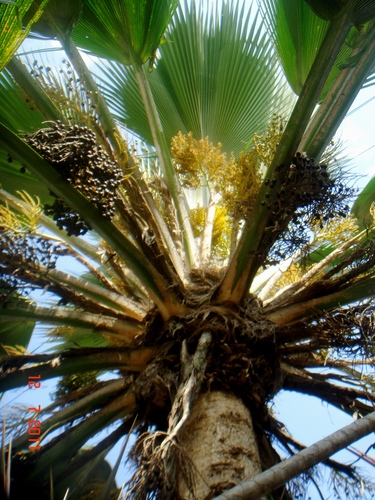Search
Wikipedia
| Pritchardia pacifica | |
|---|---|

| |
| Pritchardia pacifica in Mumbai, India | |
|
Scientific classification | |
| Kingdom: | Plantae |
| Clade: | Tracheophytes |
| Clade: | Angiosperms |
| Clade: | Monocots |
| Clade: | Commelinids |
| Order: | Arecales |
| Family: | Arecaceae |
| Genus: | Pritchardia |
| Species: |
P. pacifica
|
| Binomial name | |
|
Pritchardia pacifica | |
Pritchardia pacifica, the Fiji fan palm,[1] is a species of palm tree in the genus Pritchardia [1] that is native to Tonga. It is also found on Fiji, Samoa, and the Marquesas however these populations are likely to be human introductions.[2][3][4][5]
This species is found in tropical dry forests.[4]
Description
This species reaches a height of 15 metres (49 ft), with a smooth, grayish tan trunk 10 inches (25 cm) in diameter. The 20–30 leaves are 4 feet (1.2 m) wide and equally long, held on petioles 4 feet (1.2 m) in length. The large, flat and rounded leaves are divided 1/4-1/3 into many stiff-tipped segments. The inflorescences are composed of 1-4 panicles, shorter than or equalling the petioles in length. The panicles are branched to 2 orders, with glabrous rachillae. The flowers are followed by small, shiny dark brown to purplish black, spherical fruits, 0.4 inches (1.0 cm) in diameter.[2][3][4]
Pritchardia pacifica is considered a host for a plant disease called Lethal Yellowing that is found in Florida, Puerto Rico, and Guam.[6]
Cultivation and uses
In Fiji the leaves of Fiji fan palm were traditionally used as fans, known as Iri masei or Ai viu, that were only used by the chiefs.
A light, flexible wood was used to construct a border for the leaves. In Fijian, the term Ai viu refers to both a fan and an umbrella, as the leaves of Fiji fan palm were used for protection from both the sun and the rain. The leaf was held immediately above the head when it was raining in order and the rain rolled off the leaf behind the head. The trunk of this species was occasionally used for ridge-beams. This species was associated with the upper classes and only one or two trees were usually found in a village, as these plants provided enough leaves to meet the material needs of the village chiefs.[7]
This species is sought after by palm enthusiasts for cultivation and is widely grown as an ornamental plant throughout the Pacific. The fresh seed germinates well in high light environments with moist but well drained soil. The plants tolerate coastal spray.[2][3]
Pritchardia pacifica - MHNT
References
- ^ a b Riffle, Robert Lee; Paul Craft (2003). An Encyclopedia of Cultivated Palms. Timber Press. p. 422. ISBN 978-0-88192-558-6.
- ^ a b c Hodel, Donald (2012). Loulu: The Hawaiian palm. Honolulu: University of Hawaii Press. pp. 1, 14, 73, 171–173. ISBN 978-0824835675.
- ^ a b c Hodel, Donald (14 December 2007). "A Review of the Genus Pritchardia". Palms. 51 (Supplement).
- ^ a b c Details - Flora Vitiensis nova : a new Flora of Fiji (spermatophytes only) / Albert C. Smith. - Biodiversity Heritage Library. www.biodiversitylibrary.org. Pacific Tropical Botanical Garden. 1979. ISBN 9780915809226. Retrieved 2015-12-13.
- ^ "Manual of the Flowering Plants of Hawaii, rev. ed". www.uhpress.hawaii.edu. Retrieved 2015-12-13.
- ^ Arellano, Jose; Oropeza, Carlos (1995). Oropeza, C.; Howard, F. W.; Ashburner, G. R. (eds.). Lethal yellowing. Developments in Plant Pathology. Springer Netherlands. pp. 1–15. doi:10.1007/978-94-011-0433-3_1. ISBN 978-94-010-4193-5.
- ^ Brownlie, G. (1977). The Pteridophyte Flora of Fiji. J. Cramer. ISBN 9783768254557.





